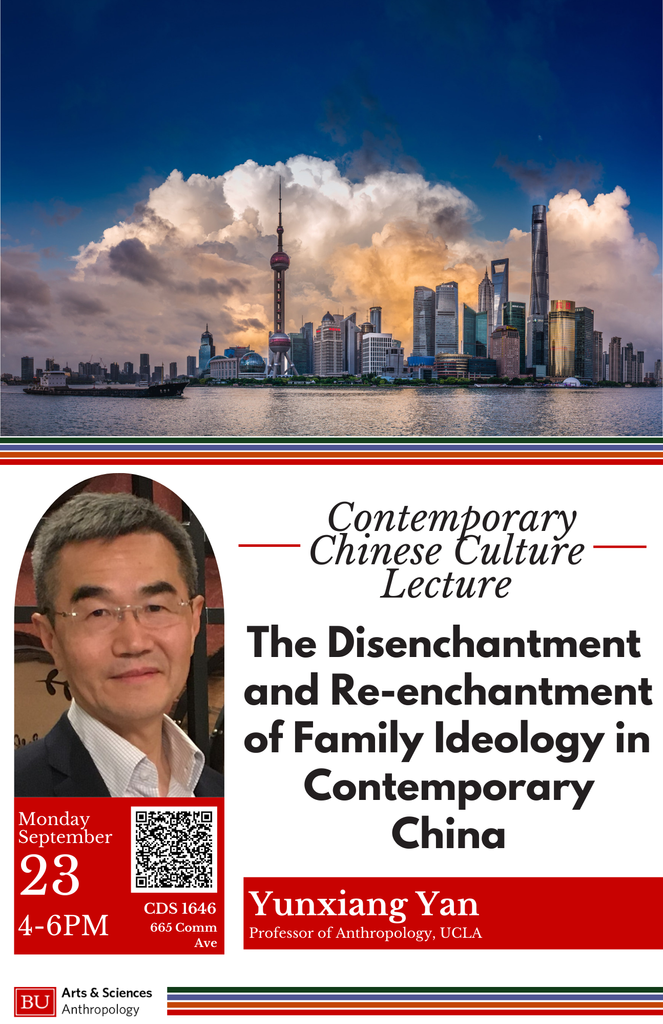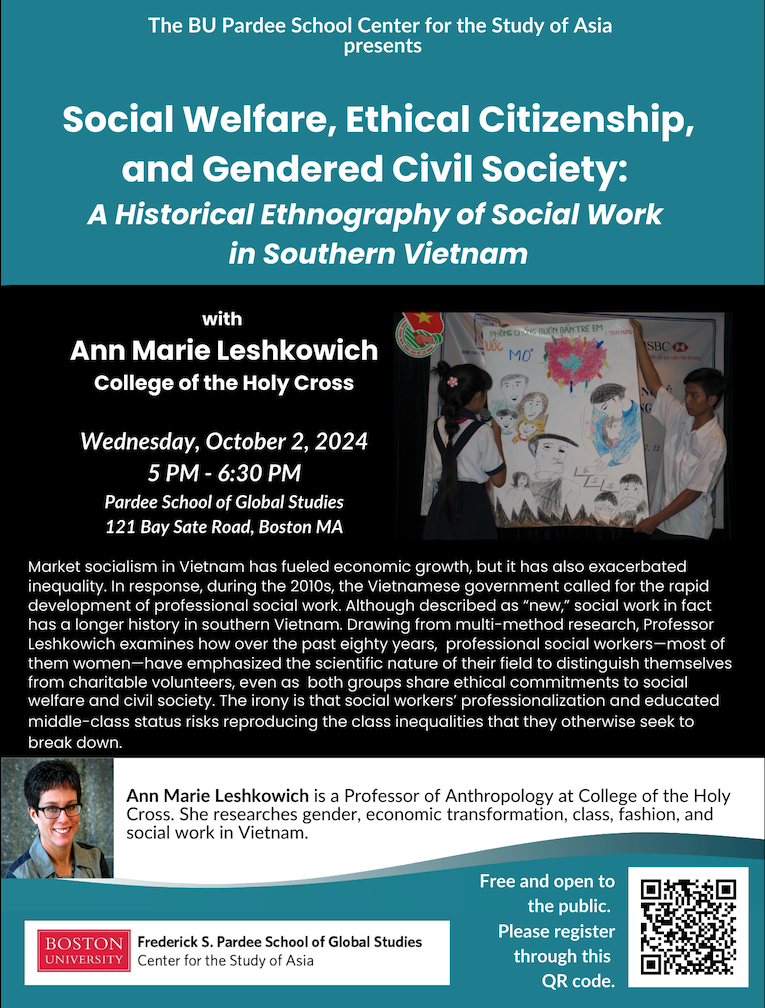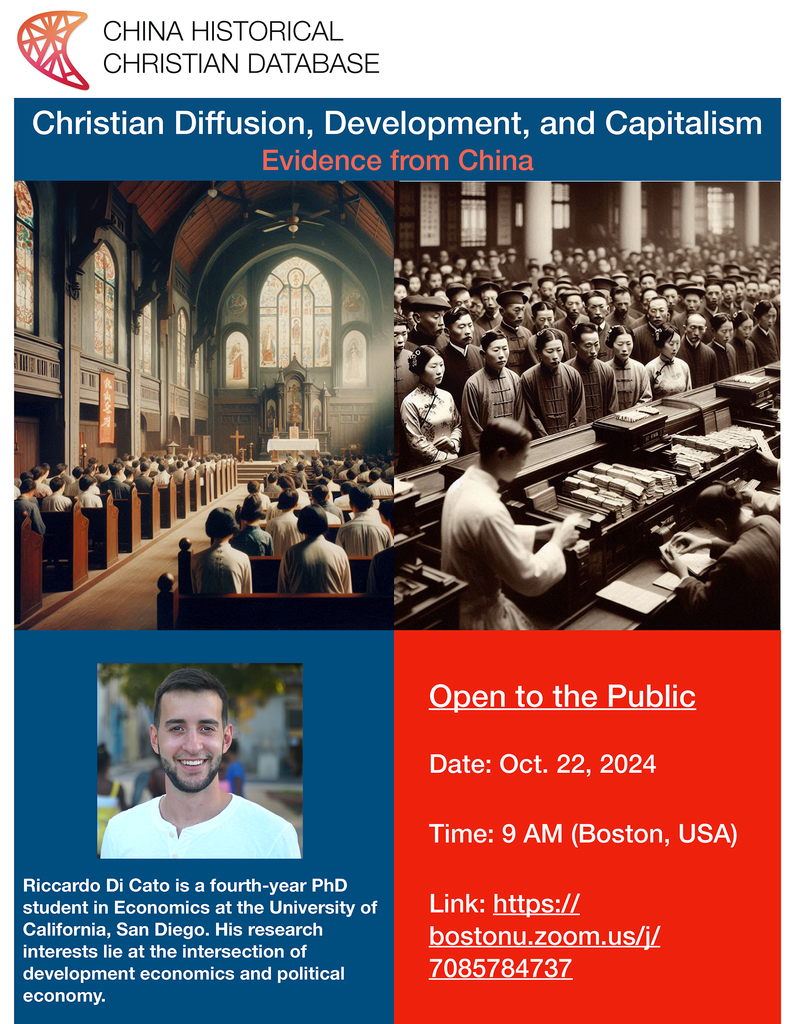History in Images, History in Words: In Search of Facts in Documentary Filmmaking
History in Images, History in Words:
In Search of Facts
in Documentary Filmmaking
A lecture by Carma Hinton
Robinson Professor of Visual Culture and Chinese Studies at George Mason University
Monday April 10, 2017 from 4-7 pm
at the Photonics Center (9th fl.), 8 St. Mary’s Street, Boston University
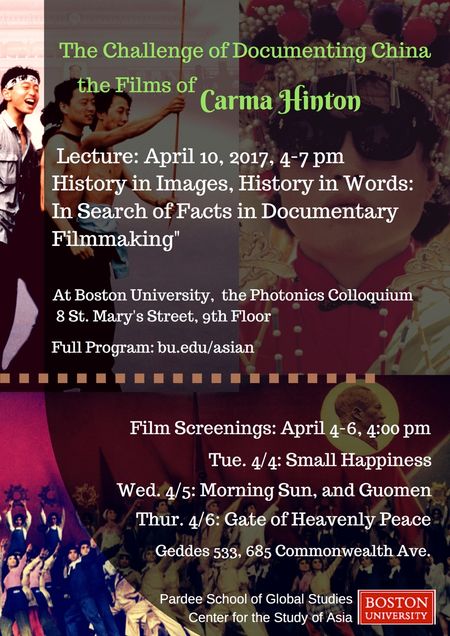 My presentation will focus on the process of documentary filmmaking, especially the many challenges my team and I faced in trying to create engaging filmic narratives that are both factually accurate and encompass multiple perspectives. I will use excerpts from my films as well as out-takes to illustrate the difficulties in determining what information to include and exclude, assess the compromises involved in the choices, and explore the consequences of taking various possible paths. I will also address the different problems that a historian encounters when presenting history in images as opposed to in words: the potential and limitation of each medium and what information each might privilege or obscure. I believe that in this age of “alternative facts” and “parallel universes,” reflections on the challenges in obtaining authenticity and truth and the importance of relentlessly striving to reach this goal, take on particularly urgent meaning.
My presentation will focus on the process of documentary filmmaking, especially the many challenges my team and I faced in trying to create engaging filmic narratives that are both factually accurate and encompass multiple perspectives. I will use excerpts from my films as well as out-takes to illustrate the difficulties in determining what information to include and exclude, assess the compromises involved in the choices, and explore the consequences of taking various possible paths. I will also address the different problems that a historian encounters when presenting history in images as opposed to in words: the potential and limitation of each medium and what information each might privilege or obscure. I believe that in this age of “alternative facts” and “parallel universes,” reflections on the challenges in obtaining authenticity and truth and the importance of relentlessly striving to reach this goal, take on particularly urgent meaning.
About the speaker:
Carma Hinton is an art historian and a filmmaker. She received her Ph.D. in Art History from Harvard University and is now Robinson Professor of Visual Culture and Chinese Studies at George Mason University. Together with Richard Gordon, Hinton has directed many documentary films, including Small Happiness, All Under Heaven, To Taste a Hundred Herbs, Abode of Illusion: The Life and Art of Chang Dai-chien, The Gate of Heavenly Peace, and Morning Sun. She has won two Peabody Awards, the American Historical Association’s John E. O’Connor Film Award, the International Critics Prize and the Best Social and Political Documentary at the Banff Television Festival, and a National News & Documentary Emmy, among others. Hinton is currently working on a book about Chinese scrolls depicting the theme of demon quelling. Carma Hinton was born in Beijing. Chinese is her first language and culture.

Witnessing War: Ogawa Kazumasa and Visual Culture in Early Twentieth-Century Japan (at Bowdoin College Art Museum, through Dec. 15, 2024)
This exhibition explores the social, cultural, and political changes taking place in Japan during the Meiji Restoration (1868–1912) through the work of Ogawa Kazumasa. One of Japan’s most prolific early photographers and publishers, Ogawa’s oeuvre included rural landscapes, geisha in Tokyo, lush flowers, ancient temples, and international conflicts—a visual record that documented the tensions of a society in transition. This exhibition focuses on a 32-volume photographic album Ogawa published featuring scenes from the Russo-Japanese War (1904–1905). Featuring selections that show field hospitals, prisoners of war, exploding cannon-fire, troops on campaigns, and more, Witnessing War explores the connections between photography, propaganda, mass media, imperialism, and global conflict at the turn of the twentieth century.
More details at https://www.bowdoin.edu/art-museum/exhibitions/2024/ogawa-kazumasa.html

Heaven and Earth: The Blue Maps of China (at the Leventhal Map & Education Center, Boston Public Library, CLOSES Aug. 31, 2024!!)
The next exhibition at the Leventhal Center, opening in May 2024, takes a close look at an extraordinary pair of maps from early nineteenth-century China. This exhibition, Heaven and Earth: The Blue Maps of China, will draw viewers into conversations about Chinese material culture, the circulation of printing techniques around the world, and the different perspectives on space and place that emerge from different intellectual traditions.
Click here to read an interview with Dr. Richard Pegg, the guest curator of Heaven and Earth, about these extraordinary maps https://www.leventhalmap.org/articles/interview-richard-pegg/?utm_source=emailoctopus&utm_medium=email&utm_campaign=2024-01-22%20General%20Newsletter)
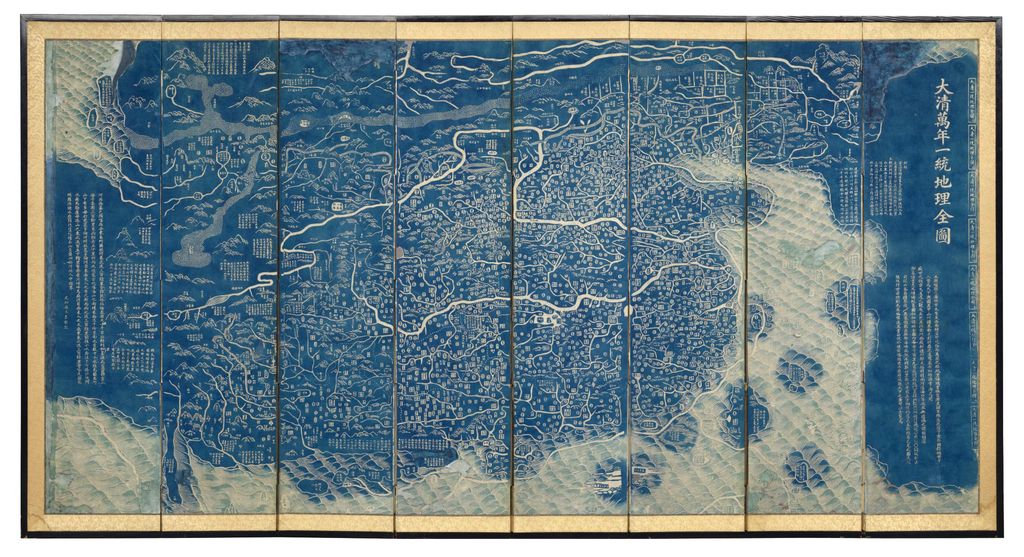

The star chart in the Adler Planetarium collection. This image features a digital edit to include the leftmost panel, which is not in this position in the original object.
TODAY! “The Disenchantment and Re-enchantment of Family Ideology in Contemporary China,” with YAN Yunxiang (UCLA) (Sept. 23, 2024)
The BU Department of Anthropology is pleased to invite you to the Contemporary Chinese Culture Lecture on Monday, Sept. 23rd with Dr. Yunxiang Yan, professor of anthropology at University of California, Los Angeles. The lecture will begin at 4pm in CDS 1646, and will be followed by a small reception. Please CLICK HERE to register.
"The Disenchantment and Re-enchantment of Family Ideology in Contemporary China"
The Chinese family ideology, broadly defined as the widely accepted ideas and ideals regarding the family institution, family relations, and family life, is currently undergoing a divergent process of reflection within public discourse, particularly among middle-class individuals. On one hand, Chinese youth are redefining the family as an instrument for personal happiness from an individualistic perspective. In doing so, they explore and highlight the burdensome aspects of family life, as seen in their reflections on marriage refusal, birth strikes, relationships with their families of origin, and the “full-time children” phenomenon. On the other hand, taking a cultural nationalist approach, a growing number of Chinese scholars are advocating for the family as the philosophical foundation of Chinese culture, the methodology of Chinese social theories, and the key to effective governance. While the former disenchant the family and may exacerbate the declining fertility rate, the latter seeks to re-enchant the family in order to establish a distinct Chinese path to modernity. The disagreement between these two strands of public discourse reveals the inherent tensions within Chinese family dynamics and society at large.
Dr. Yan is the author of The Flow of Gifts: Reciprocity and Social Networks in a Chinese Village (Stanford University Press, 1996), Private Life under Socialism: Love, Intimacy, and Family Change in a Chinese Village, 1949-1999 (Stanford University Press, 2003), and The Individualization of Chinese Society (Berg 2009). He is the editor of Chinese Families Upside Down: Intergenerational Dynamics and Neo-Familism in the Early 21st Century (Brill 2021). His research interests include family and kinship, social change, the individual and individualization, and the impact of cultural globalization.
Writing a Story of Southeast Asia, with Eric Thompson (National University of Singapore) (Sept. 24, 2024)
Join Eric C. Thompson as he discusses his new book, The Story of Southeast Asia (NUS Press, 2024), in which he examines a series of themes that have created the region as we know it today: state building (and state avoidance), adoption of popular religions, contested sovereignty, and modernity. Prof. Thompson will engage us in a discussion of how to frame the ongoing debates in Southeast Asian studies through the such questions as: What were the motivations for writing this book? Why attend to an exceptionally longue durée? What are the parallels between the adoption and spread of Theravada, Islam, Confucianism, and Christianity in the region? How can we (and should we) put colonialism in its place? And, of course, what the heck was Sriwijaya?
Writing a Story of Southeast Asia
Eric C. Thompson
(Dept. of Sociology and Anthropology, National University of Singapore)
Tuesday, Sept. 24, 2024 from 5-6:30 pm
at the Pardee School of Global Studies, 121 Bay State Road, Boston MA

TODAY!! Social Welfare, Ethical Citizenship, and Gendered Civil Society: A Historical Ethnography of Social Work in southern Vietnam, with Ann Marie Leshkowich (Weds. Oct. 2, 2024)
The development of a market-oriented economy in Vietnam over the past 35 years has fueled economic growth, rising household incomes, and consumerism, but it has also exacerbated inequality. Having earlier rejected social work as “bourgeois,” the Vietnamese government reversed course in 2010 and announced ambitious plans to train 60,000 cadres in social work by 2020. Although universities, government offices, and NGOs describe social work as a new field, it has a longer history in the southern part of the country that shapes the present-day content of its expertise and the types of people who practice it. Drawing upon participant observation, interviews, and archival research, this paper provides a historical ethnographic account of the field of social work in southern Vietnam during the last decade of French colonial rule (1945–1954), the second decade of the Republic of Vietnam (1965–1975), and the third full decade of market socialism (2010s). In all three periods, professional social workers—the majority of them women—and charitable volunteers addressed the same kinds of social problems. The two groups also shared ethical or religious commitments to improving social welfare by strengthening civil society. Yet social workers in each time period sought to distinguish themselves from charity by emphasizing the modern, scientific foundations of their practice as professionals. Just as charity can intensify power differences between givers and recipients, however, social workers’ professionalization and the middle-class status associated with it risked reproducing the very same class inequalities that they otherwise sought to break down.
About the Speaker:
![]() Professor Ann Marie Leshkowich is a sociocultural anthropologist whose ethnographic research in Vietnam focuses on gender, economic transformation, neoliberalism, middle classness, fashion, social work, and adoption. She teaches courses on such topics as Economic Anthropology, Fashion and Consumption, Contemporary Asia, Ethnographic Field Methods, and Theory in Anthropology. She earned her Ph.D. in Anthropology from Harvard University in 2000. Her publications include:
Professor Ann Marie Leshkowich is a sociocultural anthropologist whose ethnographic research in Vietnam focuses on gender, economic transformation, neoliberalism, middle classness, fashion, social work, and adoption. She teaches courses on such topics as Economic Anthropology, Fashion and Consumption, Contemporary Asia, Ethnographic Field Methods, and Theory in Anthropology. She earned her Ph.D. in Anthropology from Harvard University in 2000. Her publications include:
- Essential Trade: Vietnamese Women in a Changing Marketplace (University of Hawai'i Press, 2014) Winner of the Harry J. Benda Prize of the Association for Asian Studies, 2016.
- "Standardized Forms of Vietnamese Selfhood: An Ethnographic Genealogy of Documentation" (2014, American Ethnologist 41(1): 143-162)
- Neoliberalism in Vietnam (2012, Special issue of positions: asia critique 20(2). Co-edited with Christina Schwenkel)
- "Making Class and Gender: (Market) Socialist Enframing of Traders in Ho Chi Minh City" (2011, American Anthropologist 133(2): 277-290)
- "Wandering Ghosts of Late Socialism: Conflict, Metaphor, and Memory in a Southern Vietnamese Marketplace" (2008, Journal of Asian Studies 67(1): 5-41)
- "Woman, Buddhist, Entrepreneur: Gender, Moral Values, and Class Anxiety in Late Socialist Vietnam" (2006, Journal of Vietnamese Studies 1(1-2): 277-313)
- Niessen, Leshkowich, and Jones (eds), Re-Orienting Fashion: The Globalization of Asian Dress (Berg, 2003)
- Leshkowich and Jones, "What Happens When Asian Chic Becomes Chic in Asia?" (2003, Fashion Theory 7 (3/4): 281-300)
Global White Supremacy and the Afro-Asian Response, with Ron Richardson and Yuichiro Onishi (Thursday Oct 3, 2024)
Join in a conversation between Ron Richardson, (Department of History,Boston University) and Yuichiro Onishi (Department of African American & African Studies and Asian American Studies, the University of Minnesota) as they explore the Afro-Asian struggles against global white supremacy from the19th century to the present, with emphasis on comparative perspectives and transpacific solidarities. 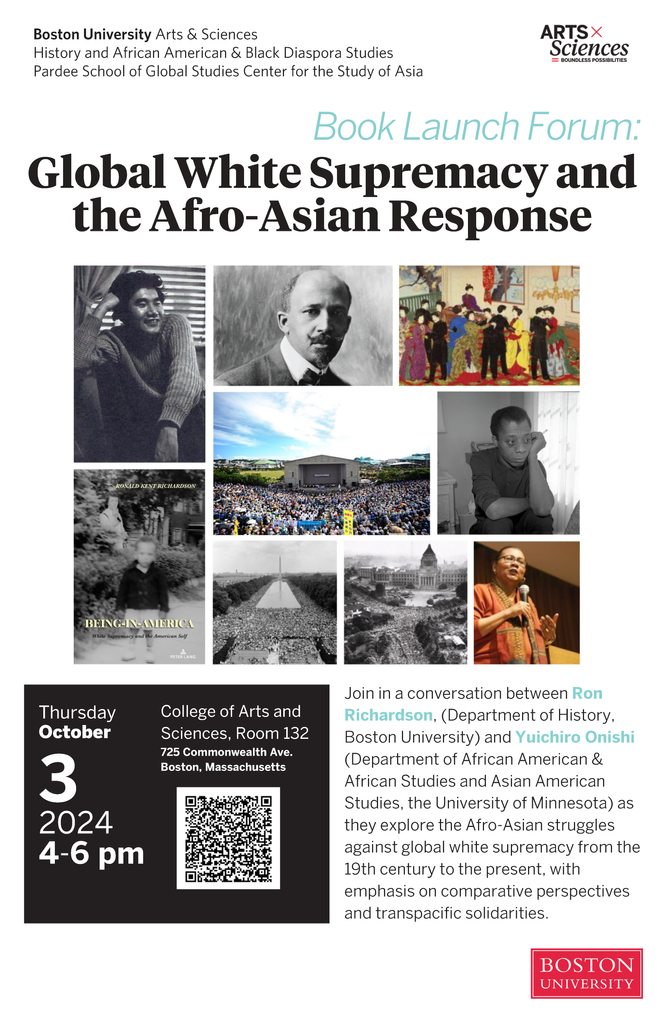 Please check this website for more information and registration.
Please check this website for more information and registration.
What’s Fair? Generational Class Consciousness in South Korea, with Aram Hur (Thursday Oct. 17, 2024)
Many aging democracies face two concerning phenomena: growing need for welfare and diminishing support for democracy among youth. Yet existing theories of economic voting cannot explain the confluence of these two trends. Using South Korea, an acute case, we show that generationally distinct beliefs about welfare deservingness—the result of differently lived developmental histories—yield distinct economic bases for democratic support. We combine text analyses of in-depth interviews, nationally representative surveys, and a survey experiment to show that while young voters base their democratic support on redistributive preferences, older voters weight these significantly less, instead evaluating democracy through the lens of economic growth. Generational class consciousness nuances the conventional understanding of democracy and redistribution and explains why some developmental states become trapped in a vicious cycle of low welfare and low democratic support.
About the Speaker:
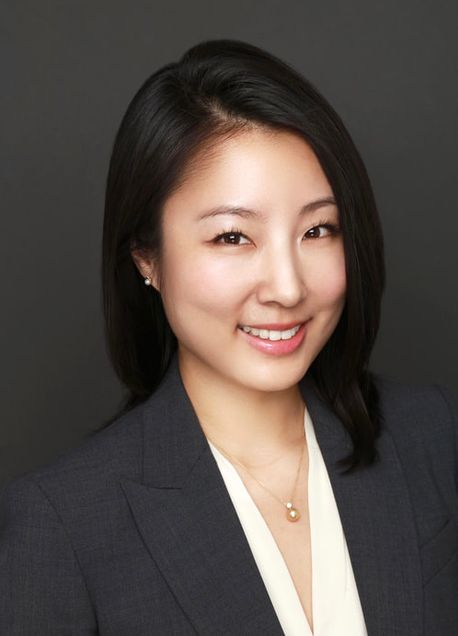 Aram Hur is Assistant Professor of Political Science and the Kim Koo Chair in Korean Studies at the Fletcher School of Law and Diplomacy, Tufts University. Her research focuses on nationalism and democracy in East Asia. She is the author of Narratives of Civic Duty: How National Stories Shape Democracy in Asia (Cornell University Press, 2022), which won the 2023 Robert A. Dahl Award for best scholarship on democracy by an untenured scholar from the American Political Science Association. She is the 2021 Sherman Emerging Scholar from The Korea Society, a CSIS U.S.-Korea NextGen scholar, and recipient of the 2023 Gold Chalk Award for teaching from the University of Missouri, where she previously taught as faculty and served as Co-Director for the MU Institute for Korean Studies. She holds a Ph.D. in Politics from Princeton University, M.P.P from the Harvard Kennedy School, and B.A. with honors from Stanford University.
Aram Hur is Assistant Professor of Political Science and the Kim Koo Chair in Korean Studies at the Fletcher School of Law and Diplomacy, Tufts University. Her research focuses on nationalism and democracy in East Asia. She is the author of Narratives of Civic Duty: How National Stories Shape Democracy in Asia (Cornell University Press, 2022), which won the 2023 Robert A. Dahl Award for best scholarship on democracy by an untenured scholar from the American Political Science Association. She is the 2021 Sherman Emerging Scholar from The Korea Society, a CSIS U.S.-Korea NextGen scholar, and recipient of the 2023 Gold Chalk Award for teaching from the University of Missouri, where she previously taught as faculty and served as Co-Director for the MU Institute for Korean Studies. She holds a Ph.D. in Politics from Princeton University, M.P.P from the Harvard Kennedy School, and B.A. with honors from Stanford University.
Christian Diffusion, Development, and Capitalism: Evidence from China, with Riccardo di Cato (UCSD) (Oct. 22, 2024)
About the speaker (from https://riccardodicato.com/)
My name is Riccardo Di Cato and I am a PhD student of Economics at UC San Diego. Before starting my PhD, I was a Predoctoral Fellow at Bocconi University working with Nicola Limodio and Filippo De Marco. Previously, I was a Research Associate for Harvard University in the Democratic Republic of the Congo in 2018-2019.
I completed my M.s. in Economics at the University of Bologna in 2018 and my B.s. in Economics at the University of Pavia in 2016.
My interests lie at the intersection between Development and Political Economy.
“The Last Breath of Sam Yan” Film Screening and Discussion with Netiwit Chotiphatphaisal and Settanant Thanakitkoses (Oct. 23, 2024)
The Boston University Initiative on Cities, Center for the Study of Asia, and Department of Anthropology
are pleased to invite you to
The Last Breath of Sam Yan
Film Screening and Discussion
with Netiwit Chotiphatphaisal and Settanant Thanakitkoses
Wednesday, October 23, 2024 from 4:00- 6:00 pm at 75 Bay State Road, Boston MA
Please register here.
About this film (from https://filmfreeway.com/TheLastBreathofSamYan)
Under the current of gentrification and the pressure from the university, an old Mazu shrine, the last member of the community, stands unwavering in the middle of the construction site, like candle light burning against a tempest. Only the caretaker of the shrine and a group of students stand in a way of this so-called “development”, in hope that the fragrance of incense and candle light will not fade from this Mazu shrine.
Prempapat Plittapolkranpim is a film director and social entrepreneur who was born in Bangkok in 1994. He began his career in filmmaking as a director in 2006, where he received a special jury prize from Movie Mania Festival, Chulalongkorn University, Thailand. In 2011, he was one of the founders of Young Filmmakers of Thailand (Public Benefit Organization), which started holding short film festivals for youths around Thailand and engaging with social issues. His film earned him the 1st prize in the Two Nations-One Mind Festival, in Busan, South Korea in 2014. He was a director of a research program for young people’s quality of life and also contributed to youth mental health issues. His project received the Best Social Change Maker Award of Thailand Influencer Awards in 2021. In 2022, he launched his first featured documentary film, which has been chosen to screen at Lift-Off Filmmaker Sessions by Lift-Off Global Network, England, and Festival del Cinema di Cefalù, Italy as well as Challenge for the World film festival, Spain. Presently, he is a special lecturer in the Technology Program (International Program). He owns Young Film TH Production and Fongmek Company Limited based in Bangkok.
The film captures and conveys the struggle to preserve the Thapthim Shrine which is being demolished by the number 1 university in Thailand. Court administrators are under intense pressure from the legal process. The film presents the concept of gentrification which is becoming a concept in urban development in many places around the world until it becomes unequal.
CANCELED – Jakarta and the Urban Grotesque, with Doreen Lee (Northeastern Univ.) (Oct. 29, 2024)
Due to unforeseen circumstance, this event has been canceled. We apologize for any inconvenience. Please email buasia@bu.edu with any questions. We hope to reschedule this event in Spring 2025.
This talk distills the flows and values of life in Jakarta, Indonesia’s largest city and financial core, into a central idea: The Urban Grotesque. The urban grotesque is a name and framework for situating the dynamic, generous, predatory, and unpredictable textures of Jakarta’s financial lives. My book manuscript follows the stories of individuals who experience and justify the high social costs of living in the city, tracking their commonplace gestures of giving and taking to build a systematic analysis of how redistribution and circulation dominate urban life. My research shows that long-standing cultural practices of exchange and reciprocity align with a fast-changing financial landscape in which neoliberal ideas are fast becoming popular. Combining ethnography and memoir, and playing with genre, the book showcases the challenges of capturing the financial edge of urban life without romanticizing the fast-paced economic developments and collective forms of resilience that characterize this Global South city.
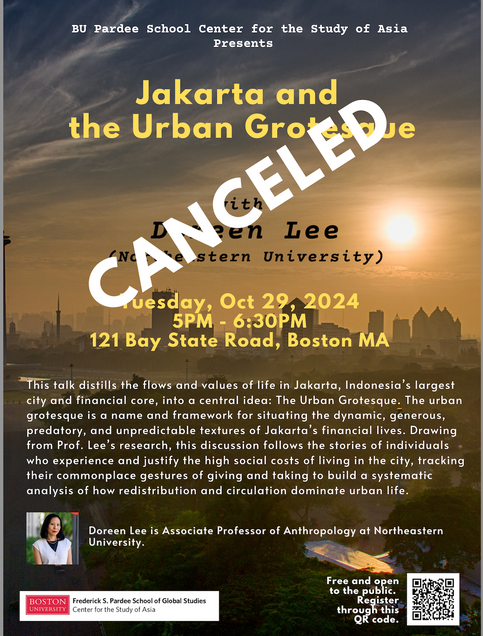
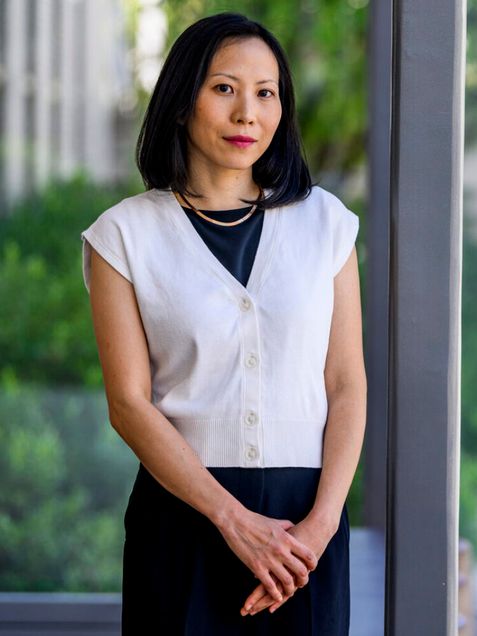
Doreen Lee is Associate Professor of Anthropology at Northeastern University. She received her PhD in Sociocultural Anthropology from Cornell University with a concentration in Southeast Asian Studies and History. She has served as the Acting Director of the Global Asian Studies program at Northeastern University and as a SEAC councilmember for AAS. Her first book Activist Archives: Youth Culture and the Political Past in Indonesia was published by Duke University Press in 2016 and won the Harry J. Benda Prize from the Association of Asian Studies in 2019. Her current book project is a demonstration of how cultures of circulation shape the financial lives of the people of Jakarta.

